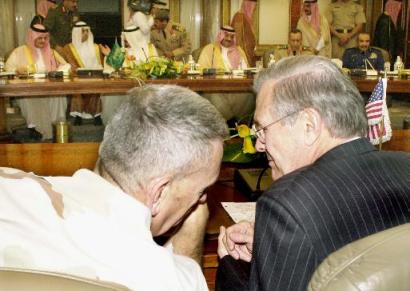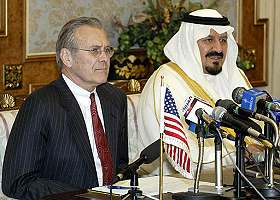 |
Home | Country Profile | Cultural Profile | Case Study | Campaign Analysis | Resources |
| Saudi Arabia : Friends of America |
 Case Study Case Study |
<<Campaign Analysis >> | Resources |
 |
Defining Public Diplomacy Pamela H. Smith who is the Minister-Counselor for Public Affairs for the U.S. Embassy in London, UK wrote a piece about public diplomacy which she defined as “To understand, inform and influence foreign publics in promotion of the national interest and to broaden the dialogue between [countries] institutions and their counterparts abroad.” As a result of globalization and the rapid development of information technology, public diplomacy has become an increasingly vital area of interest for national governments. Public opinion has become vitally important to government policy and decision-making and many governments have taken note of such trends. Traditionally, diplomacy involved sending an ‘emissary' over to another country to try and smooth tensions or problems between both governments and the information involving such dilemmas was tightly controlled. However public diplomacy has become much more complex especially in the 21st century. |
No longer can governments hide from their affairs because of the role that the media plays, the rise of independent organizations including non-Government organizations (NGOs) and the increase of modern technology such as the internet. Lobbying has also become a predominant factor of public diplomacy in which foreign governments try to influence that particular country's public opinion. Public diplomacy seeks to promote national interest and the security of the public through understanding, informing and influencing. Public diplomacy has grown especially because of the clash of cultures which was the case between Saudi Arabia and the American people after 9/11. |
|
Saudi Arabia's Diplomatic Efforts
| Immediately after 9/11 the Royal Saudi government publicly denounced the acts of the terrorists and offered its condolences and apologies to the American people. However, when it became public knowledge that 15 of the 19 hijackers were from Saudi Arabia, the government was faced with a troubling dilemma. It was put in an extremely volatile position faced with the possibility of a deteriorating public image in the United States. The government set off on an expansive and comprehensive public diplomacy campaign to try and soften its image in the United States. It was however walking the thin line of further damaging its reputation by what may have been perceived as ‘selfish' intentions to promote its image, i.e. economic incentives. The Saudi government hired Qorvis Communications, a PR firm based in Washington DC to help launch its campaign. |  |
 |
The campaign revolved around lobbying efforts, extensive media outreach and governmental involvement. In addition, the Saudi government hired a number of lobbying firms to partake in its campaign efforts and this perhaps undermined the long-term success of its campaign because it needed to be centralized because of the political-sensitivity of the situation. The Saudi embassy in the United States was the main center for publication releases and conferences. In addition, the embassy released a number of newspaper and television ads which were limited in coverage because of the number of media outlets that refused to run them and be associated with the government. The Saudi government was not ‘open' in its receptivity to media and public inquiries, which can always damage a pr campaign and the content of the ads sold an apology rather than attempted to show what actions the Saudi governments were going to take to prevent such incidents from occurring in the future. |
In terms of the imagery the main theme of the campaign was, "The People of Saudi Arabia: Allies Against Terrorism" and "The People of Saudi Arabia: Allies For Peace." And the ads featured the US and Saudi flags waving together. In addition, the US government also helped to soften Saudi's image by holding joint press conferences with the Saudi embassy, expressing their satisfaction with Saudi's efforts against terrorists and emphasizing the long-term friendship that both countries have enjoyed. However, the ads nonetheless seemed targeted more towards investors and businesses rather than the general American public. Furthermore, the media seemed more interested in covering the ongoing internal battle ensuing within the pr firm that was spearheading the campaign rather than the campaign itself. Three of the top partners at the firm had decided to leave because of their reluctance to represent the Saudi government. So this demonstrated that even the firm did not put 100% of its efforts into the campaign and this was reflected in the shallow and inconsistent outreach.